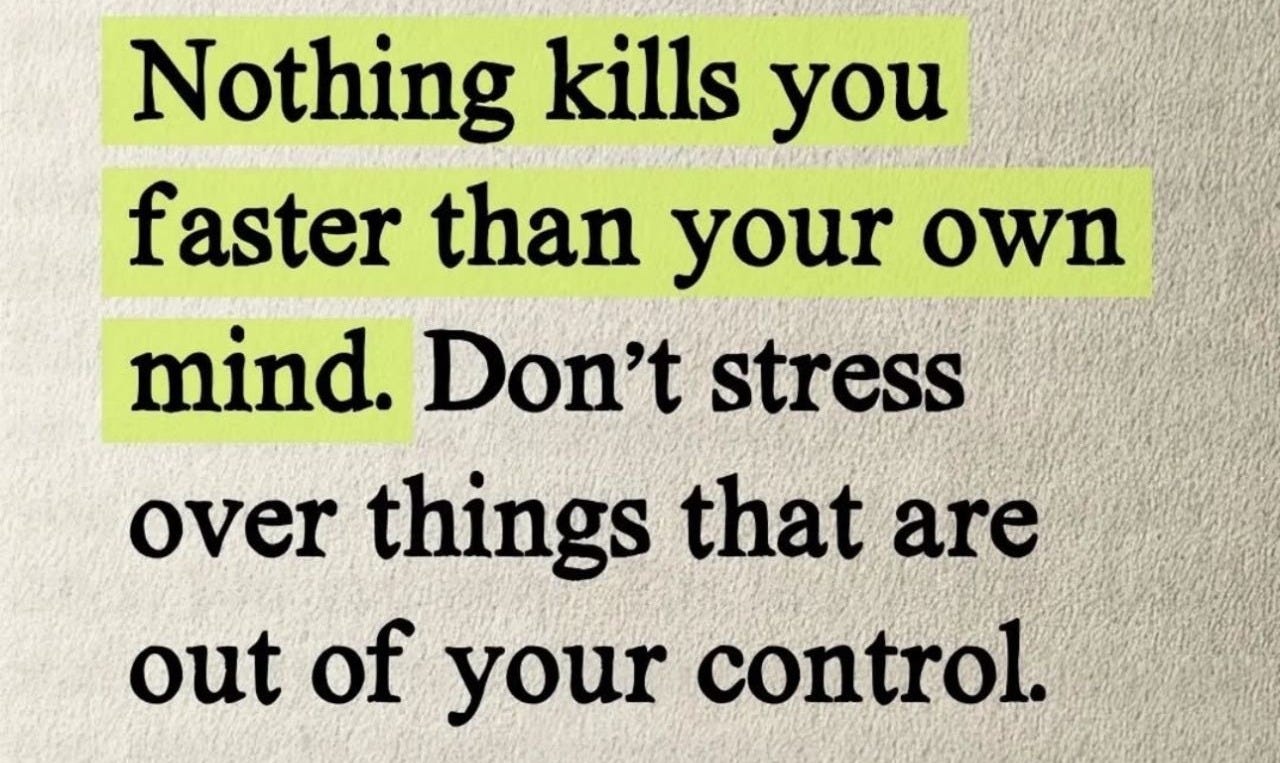Welcome to Polymathic Being, a place to explore counterintuitive insights across multiple domains. These essays explore common topics from different perspectives and disciplines to uncover unique insights and solutions.
Today's topic flips the script on anxiety and shows how much of what we fear is more in our imagination than in reality. At at time when mental health is collapsing, let’s look at the key drivers of anxiety, whether we are focused on the right threats, and uncover a few tools we can apply to counter the bullshit.
Intro to Anxiety
Anxiety isn’t a maladaptive bug of the human mind; it’s an evolutionarily honed feature underlying critical functions in our species’ history. At its foundation, anxiety enhances threat detection, quickens our response to danger, and promotes careful risk assessment. Simply put, anxiety helped our ancestors survive in an environment that regularly tries to kill us, even today.
Personal survival is the foundation, but because of our human superpower of social learning through empathy, bonding, cooperation, and attention to group norms, anxiety contributes to stronger, more cohesive communities, which in turn protect and support the individuals within them.
The discomfort we feel from anxiety is the price of vigilance and social harmony that gave our ancestors an edge both as individuals and as members of cooperative groups, allowing us to not only survive but thrive. We went from naked hominids, running with sharp sticks in the woods hunting our dinner, to aspiring polymaths typing counterintuitive insights on advanced computing technology while sipping hot coffee shipped halfway around the world.
Biology of Anxiety
Biologically, anxiety activates the sympathetic nervous system and the HPA axis (hypothalamic-pituitary-adrenal axis), flooding the body with stress hormones that sharpen reflexes and dull non-essential functions (like digestion) during emergencies. The amygdala and hippocampus then make sure that once a danger is experienced, it’s remembered and avoided in the future.
It’s important to differentiate between fear and anxiety: fear is usually a short-term response to an immediate threat, whereas anxiety involves higher-order cognition, allowing us to anticipate future threats or social outcomes.
This cognitive aspect of anxiety enables humans to learn from their own experiences and those of others. In group settings, witnessing another member’s fearful or anxious reaction can also trigger one’s own anxiety, ensuring that anxiety’s benefits are both individual and collective.
However, when we remove real threats, our brains quickly and seamlessly recalibrate through a mechanism called risk homeostasis, as we highlighted in Apocalypse Always:
The experiment extended into providing positive and negative scenarios. As fewer clear negatives were presented, more positives tipped into negatives. We see the same thing today with the reduction of overt racism being replaced by microaggressions and people still claiming that racism is as bad, or worse than ever.
Anxiety responds to valid threats, signaling a response that can save our lives. However, the more valid threats that are removed, the more we elevate less valid threats to the level of anxiety-inducing. Worse, we are so coded to look for threats that the absence of them, counterintuitively, spikes anxiety. The reason is simple; while recognized threats can harm us, it’s the unseen threats that are more likely to kill us! Our brains are so wired to expect threats that their absence triggers a panic to find them. This leads to the idea of anticipatory anxiety or, what I’m calling, bullshit anxiety.
writing explores the same challenge in the essay How To Find Self-Command In An Age Of Anxiety:I am struck that anticipatory anxiety can be a greater plague in the world of safety than in the world of hardship. It seems when concrete threats are removed, abstract threats fill the void.
Key point here from Sam is the focus on finding self-command, which is a core principle I’ll poke at in just a minute.
Compounding the Problem
Adding to risk homeostasis and anticipatory anxiety is the recent and terrible idea that any and all trauma is bad. In a catch 22, the very real trauma that used to exist is largely gone, replaced by anxiety about etheral threats. Yet, at the same time, we try to avoid any and all trauma, even when it will help us become stronger mentally.
Allen Frances’s book, Saving Normal, explores how pharmaceutical companies profit from what he terms “the worried well.” These folks are suffering from bullshit anxiety. However, Psychiatrists and Therapists profit because the worried well are easy to treat, pay regularly, and keep showing up. They’re easier than treating a schizophrenic, manic depressive, or Cluster B case. Bullshit anxiety is profitable!
Abigail Shrier discovered the same in her book Bad Therapy. Therapists have an incentive to encourage you to return. They don’t want to solve your problems because then you don’t have to return. Worse, when it comes to therapy, studies have shown over and over that anyone, especially children and those who have not developed their coping and problem resolution skills, suffers from constantly reliving trauma, real or otherwise. It actually encodes that trauma vs. creating an antifragile response.
Taking Action
Anxiety is a critical survival mechanism that we’ve evolved over the years. The problem is that it’s been hijacked by three things:
Risk Homeostasis occurs when we worry we are missing something important and end up suffering from imagined slights rather than real threats.
We actively strive to avoid trauma, even when it’s healthy and normal.
The incredible monetary incentives convince us that we need pharmaceuticals and therapy for normal life.
This results is inventing things to fear, losing control of our agency, and crumpling into a fragile pile of bullshit anxiety that’s belied by the amazing world we live in. As Seneca the Younger said 2000 years ago:
“We suffer more in imagination than in reality”
Or as Sam says in his article above:
“The anxious suffer twice: first in imagination, then in reality.”
Combining anticipatory anxiety with an aversion to trauma, all you are left with is a huge steaming pile of bullshit anxiety. You fear things that won’t harm you while avoiding things that will help you grow stronger. It’s a nightmare that’s exploded across our advanced nations with crippling mental health, rock bottom relationships, constant states of fear of others, political division and more.
Thankfully, there are two major steps we can take to counteract these issues.
Recognize that our minds are naturally antifragile and that trauma, especially emotional and mental trauma, can be converted to growth and strength:
Understand that we can domesticate our emotions, not eliminate them, and that life is difficult and that’s a feature, not a pathology.
Life is hard. Nature isn’t nice. The future will kill you. Humans are mean.
As we accept this, we can let go of the bullshit anxiety and focus on what is going well while working to recalibrate our risk homeostasis to differentiate the real and legitimate threats from our imagination. With this recalibration, we’ll also be mentally healthier to deal with even greater challenges than we ever thought possible.
Did you enjoy this post? If so, please hit the ❤️ button above or below. This will help more people discover Substacks like this one, which is great. Also, please share here or in your network to help us grow.
Polymathic Being is a reader-supported publication. Becoming a paid member keeps these essays open for everyone. Hurry and grab 20% off an annual subscription. That’s $24 a year or $2 a month. It’s just 50¢ an essay and makes a big difference.
Further Reading from Authors I Appreciate
I highly recommend the following Substacks for their great content and complementary explorations of topics that Polymathic Being shares.
- All-around great daily essays
- Insightful Life Tips and Tricks
- Highly useful insights into using AI for writing
- Integrating AI into education
- Powerful insights to the philosophy of agency











I'm calling BS here! I think that trivializing anxiety in this manner would be an offense to all those who have to deal with this illness.
Good lead in to our idea of Slowicism, eventually!